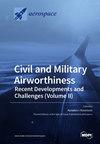Calculation and Selection of Airfoil for Flapping-Wing Aircraft Based on Integral Boundary Layer Equations
IF 2.2
3区 工程技术
Q2 ENGINEERING, AEROSPACE
引用次数: 0
Abstract
The flight of a migratory bird-like flapping-wing aircraft is characterized by a low Reynolds number and unsteadiness. The selection of airfoil profiles is critical to designing an efficient flapping-wing aircraft. To choose the suitable airfoil for various wing sections, it is necessary to calculate the aerodynamic forces of the unsteady two-dimensional airfoil with a Reynolds number in the range of 105. While accurate, calculating this by solving the Navier–Stokes equations is impractical for early design stages due to its high consumption of computing resources and time. The computational demands for extending it to 3D aerodynamic calculations are even more prohibitive. In this paper, a relatively simple method is proposed. The two-dimensional unsteady panel method is utilized to derive the inviscid flow field, the unsteady integral boundary layer method is utilized to solve the boundary layer viscous flow, and the eN transition model is adopted to predict the position of the transition. These models are coupled with the semi-inverse interaction method to solve the aerodynamics of the unsteady low-Reynolds-number two-dimensional airfoil. The unsteady aerodynamics of the symmetric and cambered airfoils at different wing sections are calculated respectively by the proposed method. Mechanism analysis of the calculation results is conducted, and a symmetrical airfoil or a slightly cambered airfoil is recommended for the wing tip, a moderately cambered airfoil is suggested for the outer-wing section, and a highly cambered airfoil is suggested for the inner-wing section.基于边界层积分方程的扇翼机翼面计算与选择
候鸟式拍翼飞机的飞行特点是雷诺数低和不稳定。机翼轮廓的选择对于设计高效的拍翼飞机至关重要。要为不同翼段选择合适的翼面,必须计算雷诺数在 105 范围内的二维非稳定翼面的气动力。通过求解纳维-斯托克斯方程进行计算虽然准确,但由于需要消耗大量计算资源和时间,因此在早期设计阶段并不实用。将其扩展到三维空气动力学计算所需的计算资源甚至更多。本文提出了一种相对简单的方法。利用二维非稳态面板法推导无粘性流场,利用非稳态积分边界层法求解边界层粘性流,并采用 eN 过渡模型预测过渡位置。这些模型与半逆向相互作用方法相结合,求解了低雷诺数二维机翼的非稳态空气动力学。利用所提出的方法分别计算了对称翼面和外凸翼面在不同翼面截面上的非稳态空气动力学。对计算结果进行了机理分析,建议翼尖采用对称翼面或轻度外倾翼面,翼外段采用中度外倾翼面,翼内段采用高度外倾翼面。
本文章由计算机程序翻译,如有差异,请以英文原文为准。
求助全文
约1分钟内获得全文
求助全文
来源期刊

Aerospace
ENGINEERING, AEROSPACE-
CiteScore
3.40
自引率
23.10%
发文量
661
审稿时长
6 weeks
期刊介绍:
Aerospace is a multidisciplinary science inviting submissions on, but not limited to, the following subject areas: aerodynamics computational fluid dynamics fluid-structure interaction flight mechanics plasmas research instrumentation test facilities environment material science structural analysis thermophysics and heat transfer thermal-structure interaction aeroacoustics optics electromagnetism and radar propulsion power generation and conversion fuels and propellants combustion multidisciplinary design optimization software engineering data analysis signal and image processing artificial intelligence aerospace vehicles'' operation, control and maintenance risk and reliability human factors human-automation interaction airline operations and management air traffic management airport design meteorology space exploration multi-physics interaction.
 求助内容:
求助内容: 应助结果提醒方式:
应助结果提醒方式:


